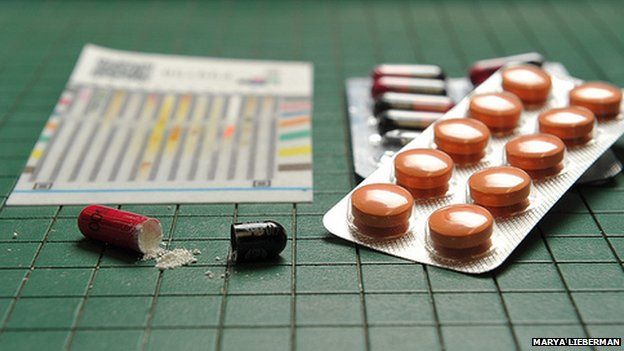'Lab on a card' spots poor quality drugs that can kill
- Published

At the Moi Teaching and Research Hospital in Eldoret, Kenya, pharmacists have a "drawer of shame".
In it, they put drugs which look suspicious, because they are either fake or of poor quality.
Rather than making people better, poor quality medicines prolong their sickness, often cause side-effects and increase the risk of drug resistance - leading to more illness and deaths, particularly among children.
While counterfeit medicines are deliberately mislabelled and mis-sold by criminals, poor quality pharmaceuticals are a silent killer because they look genuine.
Mini lab
And it is thanks to a cheap, paper-based screening tool that pharmacist Mercy Maina and her colleagues are able to check on the ingredients of the medicines they prescribe to patients in Eldoret.
The tool is known as a PAD (Paper Analytical Device) and is essentially a mini lab on a piece of card, Mercy explains.
"It's simple, you apply the tablet on a specific area on the device, dip the card in water and wait for a colour reaction, then compare the results to a standard to interpret the results."
Each of the cards contains 12 separate strips which react with a drug to create a "coloured bar code" that gives information about its chemical content.
Using the card, they have been able to determine the quality of a wide variety of antibiotics, anti-malarial drugs and tuberculosis medication, and report any odd results to the Kenya Pharmacy and Poisons Board while filling up their "drawer of shame".
The poor quality drugs may look like the real thing but they don't work properly - usually because of mistakes made during the manufacturing process, poor storage conditions (in hot temperatures) and inadequate transportation.
'Global pandemic'
No-one really knows the scale of the global problem of low-quality medicines because the data is so hard to come by, but experts agree that it is now a serious international public health issue.
Research published in the Malaria Journal in 2014 said that poor quality medicines "threaten the lives of millions of patients and are alarmingly common in many parts of the world".
Experts writing in the American Journal of Tropical Medicine and Hygiene recently called the proliferation of falsified and sub-standard medicines "a global pandemic".
And it is in developing countries, like Kenya, that the problem is most acute.
A recent national quality control survey in the country suggested that around 25% of drugs could be sub-standard.
Prof Paul Newton, an expert in drug quality from the Worldwide Antimalarial Resistance Network, says the exact figure doesn't really matter.
"I would argue that even if 1% of the anti-malarial supply is poor quality that will be an important public health problem.
"As malaria is so common, many people will be affected with more sickness and death than they should have been if the medicines had been of good quality."
The WHO estimates that 30% of countries have no drug regulation body or one that doesn't function well enough - and that means there is a serious lack of quality control.
So out in the field, attention is focused on testing the quality and authenticity of drugs before they are sold to patients.
White powders
Prof Marya Lieberman, from Notre Dame University in the US, who devised the Pad project four years ago, says the device has the ability to test 36 different drugs at the moment.
The results have been revealing - they have found drugs diluted with paracetamol, which only relieves symptoms as opposed to fighting off disease.
Other drugs have been found to contain hidden amoxicillin (to which people can be dangerously allergic), and tests on fake medicines have unearthed evidence of starch, maize meal and a variety of unidentifiable white powders.
The device can't test all possible fake formulations because some drugs don't contain the right groups of chemicals to test for, but it does have huge potential, Prof Lieberman says.
"Fewer than 10% of people are tested for diabetes in developing countries so we are poised to check the quality of these medications when they are prescribed, in a big way."
A low cost paper based test to help patients spot counterfeit drugs is being trialled in Kenya
Because the card is very straightforward to use, anybody can be trained to use it - and that's important in countries with few resources.
But testing medicines to find out if they are good quality "is just one component of what needs to be done", says Prof Newton.
'Lack of political will'
So, who is is to blame for the rise in low-quality medicines?
"It is a failure on many fronts," he says, citing the lack of investment in medicine regulation and some pharmaceutical companies not investing in appropriate quality assurance and quality control to ensure that they produce good-quality products.
There is also "a lack of political will to ensure that manufactured medicines comply with national and international standards."
Manufacturers have also been accused of sloppiness, of sacrificing the quality of the drugs they make to save money.
When pharmaceuticals have such a huge impact on global health and the potential to save millions of lives in developing countries, where malaria and other diseases are rife, low-quality drugs are a hidden killer which scientists are determined to weed out.
- Published7 June 2015